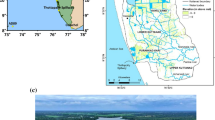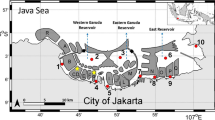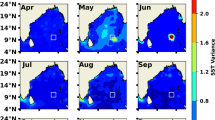Abstract
The intensity and frequency of extreme events due to climate change in the future will most likely increase, as suggested in the sixth IPCC assessment report. Climate change has been propounded as one of the prominent causes of the ocean’s extreme events, particularly those associated with atmosphere–sea interaction occurring in the tropical region of Indonesia. A typhoon is an extreme event that forms in the Western North Pacific Ocean and causes changes in oceanographic parameters in a region far from its origin point. Thus, the goal of this study is to investigate how extreme events like Hagibis and Mitag typhoons affect the Significant Wave Height (SWH) in Jakarta Bay, particularly in the reclamation areas. SWH changes in Jakarta Bay due to the reclamation of Kita, Maju, and Bersama coastal areas have been simulated during both typhoons from 19th to 27th November 2007. The simulation was run from 1st October to 31st December 2007 using the Simulating WAve Nearshore (SWAN) model, and it was performed for two scenarios of pre-reclamation and post-reclamation. The analysis used a lagged correlation between wind speed magnitude in the study area within the South China Sea (SCS) and Indonesian Archipelago and SWH in Jakarta Bay from 19th November to 13th December 2007. It was found that the amplification of SWH changes in Jakarta Bay was associated with swell propagation from the SCS and Philippines, where Hagibis and Mitag typhoons were formed. The result exhibited that the most affected SWH due to the peak phase of Hagibis and Mitag typhoons (23rd November 2007) in Jakarta Bay was after an 11-day travel time, which was on 4th December 2007 compared to other dates. Hence, SWH during post-reclamation with regard to the three established reclamation areas (Kita, Maju, and Bersama coastal areas) responded to changes in SWH in Jakata Bay by up to 38.82% and down to 1.75% in Maju and Kita coastal areas, respectively.













Similar content being viewed by others
References
Akpınar A, Vledder GPV, Kömürcü MI, Ózger M (2012) Evaluation of the numerical wave model (SWAN) for wave simulation in the Black Sea. Cont Shelf Res 50:80–99
Becq-Girard F, Forget P, Benoit M (1999) Non-linear propagation of unidirectional wave fields over varying topography. Coast Eng 38:91–113
Bi F, Song JB, Wu KJ, Xu Y (2015) Evaluation of the simulation capability of the Wavewatch III model for Pacific Ocean wave. Acta Oceanol Sin 34:43–57
Bowditch LD (2002) The American Practical Navigator. US-National Imagery and Mapping Agency, Ref. NVPUB9VI
Caires S, Swail VR, Wang XLL (2006) Projection and analysis of extreme wave climate. J Clim 19:5581–5605
Cavaleri L, Malanotte-Rizzoli P (1981) Wind wave prediction in shallow water: theory and applications. J Geophys Res 86(C11):10961–10973
Chen YP, Xie DM, Zhang CK, Qian XS (2013) Estimation of long-term wave statistics in the East China Sea. J Coast Res 65:177–182
Chen G, Chapron B, Ezraty R, dan Vandemark DA (2002) Global view of swell and wind sea climate in the ocean by satellite altimetry and scatterometer. American Meteorological Society
Divinsky BV, Kosyan RD (2017) Spatiotemporal variability of the Black Sea wave climate in the last 37 years. Cont Shelf Res 136:1–19
Eldeberky Y (1996) Nonlinear transformation of wave spectra in the nearshore zone. PhD. thesis. Delft University of Technology, Department of Civil Engineering, the Netherlands
Feng J, Jiang W (2015) Extreme water level analysis at three stations on the coast of the Northwestern Pacific Ocean. Ocean Dyn 65(11):1383–1397. https://doi.org/10.1007/s10236-015-0881-3
Feng X, Tsimplis MN (2014) Sea level extremes at the coasts of China. J Geophys Res Oceans 119(3):1593–1608. https://doi.org/10.1002/2013jc009607
Feng J, Storch H, Jiang W, Weisse R (2015) Assessing changes in extreme sea levels along the coast of China. J Geophys Res Oceans 120:8039–8051. https://doi.org/10.1002/2015JC011336
French CE, French JR, Clifford NJ, Watson CJ (2000) Sedimentation erosion dynamics of abandoned reclamations: the role of waves and tides. Cont Shelf Res 20:1711–1733
Gallagher S, Tiron R, Dias F (2014) A long-term nearshore wave hindcast for Ireland: Atlantic and Irish Sea coasts (1979–2012). Ocean Dyn 64:1163–1180
Gallagher S, Gleeson E, Tiron R, Mcgrath R, Dias F (2016) Wave climate projections for Ireland for the end of the 21st century including analysis of EC-Earth winds over the North Atlantic Ocean. Int J Clim 36:4592–4607
Guo LL, Perrie W, Long ZX, Toulany B, Sheng JY (2015) The impacts of climate change on the autumn North Atlantic wave climate. Atmos Ocean 53:491–509
Hanifah F, Ningsih NS (2018) Identifikasi Tinggi dan Jarak Genangan Daerah Rawan Bencana Rob di Wilayah Pantai Utara Jawa yang Disebabkan Gelombang Badai Pasang dan Variasi Antar-Tahunan. Jurnal Teknik Sipil 25(1):81–86
Haryanto YD, Riama NF, Purnama DR, Sigalingging AD (2021) The effect of the difference in intensity and track of tropical cyclone on significant wave height and wave direction in the Southeast Indian Ocean. Sci World J 2356–6140. https://doi.org/10.1155/2021/5492048
Hasselmann K, Barnett TP, Bouws E, Carlson H, Cartwright DE, Enke K, Ewing JA, Gienapp H, Hasselmann DE, Kruseman P, Meerburg A, Mueller P, Olbers DJ, Richter K, Sell W, Waiden H (1973) Measurements of wind-wave growth and swell decay during the JOint North Sea WAve Project (JONSWAP). Dtsch Hydrogr Z SuppL 12(A8):1–95
He HL, Xu Y (2016) Wind-wave hindcast in the Yellow Sea and the Bohai Sea from the year 1988 to 2002. Acta Oceanol Sin 35:46–53
He HL, Song JB, Bai YF, Xu Y, Wang JJ, Bi F (2018) Climate and extrema of ocean waves in the East China Sea. Sci Chin Earth Sci 7:1–15
Holthuijsen LH (2007) Waves in oceanic and coastal waters. Cambridge University Press, New York
Hongsheng C, Xishan P, Chunhui L, Yan W, Shaopeng W (2019) Influence of Large-scaled Reclamation on the Cold Wave in Coastal Area of Jiangsu Province, 6th International Conference on Coastal and Ocean Engineering. IOP Conf. Series: Earth and Environmental Science, 2019, 326, 012003. https://doi.org/10.1088/1755-1315/326/1/012003
Hu Y, Shao W, Wei Y, Zuo J (2020) Analysis of Typhoon-Induced Waves along Typhoon Tracks in the Western North Pacific Ocean, 1998–2017. J Mar Sci Eng 8(7):521. https://doi.org/10.3390/jmse8070521
Hwang PA, Bratos SM, Teague WJ, Wang DW, Jacobs GA, Resio DT (1999) Winds and waves in the yellow and east China seas: A comparison of space-borne altimeter measurements and model results. J Oceanogr 55:307–325
Japan Meteorological Agency (2007) Annual Report on the Activities of the RSMC Tokyo - Typhoon Center
Kim TR, Lee JH (2018) Comparison of high wave hindcasts during Typhoon Bolaven (1215) using SWAN and WAVEWATCH III model. J Coast Res 85:1096–1100
Komen GJ, Hasselmann S, Hasselmann K (1984) On the existence of a fully developed windsea spectrum. J Phys Oceanogr 14:1271–1285
Li JX, Chen YQ, Pan SQ (2016) Modelling of Extreme Wave Climate in China Seas. J Coast Res 75:522–526
Liang BC, Liu X, Li HJ, Wu YJ, Lee DY (2014) Wave Climate Hindcasts for the Bohai Sea, Yellow Sea, and East China Sea. J Coast Res 32:172–180
Markina MY, Gavrikov AV (2016) Wave climate variability in the North Atlantic in recent decades in the winter period using numerical modeling. Oceanology 56:320–325
Masson-Delmotte V, Zhai P, Pirani A, Connors SL, Péan C, Berger S, Caud N, Chen Y, Goldfarb L, Gomis MI, Huang M, Leitzell K, Lonnoy E, Matthews JBR, Maycock TK, Waterfield T, Yelekçi O, Yu R, Zhou O (eds) (2021) Summary for Policymakers. In: Climate Change 2021: The Physical Science Basis. Contribution of Working Group I to the Sixth Assessment Report of the Intergovernmental Panel on Climate Change. Cambridge University Press, Cambridge
Ningsih NS, Hadi S, Utami MD, Rudiawan AP (2011b) Modelling of storm tide flooding along the southern coast of Java, Indonesia. In: Satake K, Gan J (Eds) Advances in geosciences, World Scientific Publishing Company, Singapore, Vol. 24, 87–103
Ningsih NS, Rachman A, Hadi S, dan Hanifah F (2019) Seas and Swell Dynamics from South China Sea to Jakarta Bay: case study of Hurricane Hagibis Incident, November 2007. Jurnal Teknik Sipil 26(1):59–66. ISSN 0853-2982. https://doi.org/10.5614/jts.2019.26.1.8
Ningsih NS, Suryo W, Anugrah SD (2011a) Study on Characteristics of Residual Water Level in Jakarta, Semarang, and Surabaya Waters - Indonesia and its relation to storm events in November 2007. In: International Journal of Basic and Applied Sciences IJBAS-IJENS, 11, 05
Ningsih NS, Hanifah F, Tanjung TS, Yani LF, Azhar MA (2020) The effect of tropical cyclone Nicholas (11–20 February 2008) on Sea Level Anomalies in Indonesian Waters. J Mar Sci Eng 8:948. https://doi.org/10.3390/jmse8110948
Pan H, Liu F (1994) A numerical study of the tide-surge interaction in the East China Sea and the South China Sea. Chin J Oceanol Limnol 12(1):13–21
Park YH, Suh K-D (2012) Variations of storm surge caused by shallow water depths and extreme tidal ranges. Ocean Eng 55:44–51
Ramly S (2008) Impact on the coastal areas of the Tanjung Tokong Land Reclamation Project, Penang, Malaysia Effects on wave transformation, sediment transport, and coastal evolution. Department of Building and Environmental Technology, Lund University, Sweden
Rizal AM, Ningsih NS (2020) Ocean wave energy potential along the west coast of the Sumatra island, Indonesia. J Ocean Eng Mar Energy 6(2):137–154. ISSN: 2198-6444. https://doi.org/10.1007/s40722-020-00164-w
Rizal AM, Ningsih NS, Sofian I, Hanifah F, Hilmi I (2019) Preliminary study of wave energy resource assessment and its seasonal variation along the Southern Coasts of Java, Bali, and Nusa Tenggara Waters. J Renew Sustain Energy 11(1):014502. ISSN 1941-7012, https://doi.org/10.1063/1.5034161
Saputri DF (2009) The Study of Rob’s Run-up and Inundation on the Coast of North Jakarta 588 caused by Tides (Case Study: 24–27 November 2007). Study Program of Oceanography, Institut Teknologi, Bandung
Sartini L, Mentaschi L, Besio G (2015) Comparing different extreme wave analysis models for wave climate assessment along the Italian coast. Coast Eng 100:37–47
Semedo A, Suselj K, Rutgersson A, dan Sterl A (2011) A Global View on the Wind Sea and Swell Climate and Variability from ERA-40. American Meteorological Society, New York
Shena Y, Jiaa H, Lid C, Tang J (2018) Numerical simulation of saltwater intrusion and storm surge effects of reclamation in Pearl River Estuary. Chin Appl Ocean Res 79:101–112
Shukla RP, Kinter JL, Shin CS (2018) Sub-seasonal prediction of significant wave heights over the Western Pacific and Indian Oceans, part II: The impact of ENSO and MJO. Ocean Model 123:1–15
Sofian I (2012) Storm-Surge Simulation in Bangka Strait Using the Coupled ADCIRC and SWAN models. Majalah Ilmiah Globe 14(2)
Sun L, Li Y-X, Yang Y-J, Wu Q, Chen X-T, Li Q-Y, Li Y-B, Xian T (2014) Effects of super typhoons on cyclonic ocean eddies in the western North Pacific: a satellite data-based evaluation between 2000 and 2008. J Geophys Res: Oceans 119(9):5585–5598. https://doi.org/10.1002/2013jc009575
Sya-bana RK (2015) Coastal Wave Mapping Using Numerical Modelling Method at Jakarta Bay Before and After Jakarta Giant Sea Wall Construction, Tugas Akhir, Program Studi Teknik Geodesi dan Geomatika, Fakultas Ilmu dan Teknologi Kebumian, Institut Teknologi Bandung
The SWAN Team (2019) SWAN scientific and technical documentation
Tseng Y-H, Jan S, Dietrich DE, Lin I-I, Chang Y-T, Tang T-Y (2010) Modeled oceanic response and sea surface cooling to Typhoon Kai-Tak. Terrest Atmos Ocean Sci 21(1):85–98. https://doi.org/10.3319/tao.2009.06.08.02(iwnop)
Wang YP, Gao S, Jia J, Thompson CEL, Gao J, Yang Y (2012) Sediment transport over an accretional intertidal flat with influences of reclamation. Jiangsu Coast Chin Mar Geol 291–294:147–161
Webster PJ, Holland GJ, Curry JA, Chang HR (2005) Changes in tropical cyclone number, duration, and intensity in a warming environment. Science 309:1844–1846
Wei C-C, Hsieh C-J (2018) Using Adjacent Buoy Information to Predict Wave Heights of Typhoons Offshore of Northeastern Taiwan. Water 10(12):1800. https://doi.org/10.3390/w10121800
Widodo A (2014) Analyzing Indonesia’s NCICD Project to Stop the Capital City Sinking. Jurnal Ilmu Pemerintahan 7(2):54–66
World Meteorological Organization (WMO) (1998) Guide to wave analysis and forecasting. Secretariat of the World Meteorological Organization, Geneva
Xu J-L, Zhang Y-H, Cao A-Z, Liu Q, Lv X-Q (2015) Effects of tide-surge interactions on storm surges along the coast of the Bohai Sea, Yellow Sea, and East China Sea. Sci Chin Earth Sci 9:1–9. https://doi.org/10.1007/s11430-015-5251-y
Yang Y-J, Sun L, Duan A-M, Lie Y-B, Fu Y-F, Yang YF, Wang Z-Q, Xian T (2012) Impacts of the binary typhoons on upper ocean environments in November 2007. J Appl Remote Sens 6(1):063583. https://doi.org/10.1117/1.JRS.6.063583
Yani LF (2018) The Effect of Jakarta Bay Reclamation on Sea Level Rise by Storm Tide. Study Program of Oceanography, Institut Teknologi Bandung
Yin B-S, Xu Z-H, Huang Y, Lin X (2009) Simulating a typhoon storm surge in the East Sea of China using a coupled model. Nat Sci 19:65–71
Zhang W-Z, Lin S, Jiang X-M (2016) Influence of tropical cyclones in the Western North Pacific, recent developments in tropical cyclone dynamics, prediction, and detection. In: Anthony L (ed) University of Missouri. https://doi.org/10.5772/64009
Zhang M-Y, Li Y-S (1996) The synchronous coupling of a third-generation wave model and a two-dimensional storm surge model. Ocean Eng 23(6):533–543
Zhang H, Sheng J-Y (2015) Examination of extreme sea levels due to storm surges and tides over the northwest Pacific Ocean. Cont Shelf Res 93:81–97
Zhang W-Z, Shi F, Hong H-S, Shang S-P, Kirby JT (2010) Tide-surge interaction intensified by the Taiwan Strait. J Geophys Res Ocean 115:C06012. https://doi.org/10.1029/2009jc005762
Zhang W, Qian Y (2001) Seasonal variations of convective activities over the South Cina Sea and its neighbourhood and their comparative analyses in the strong and weak convection years. Acta Meteorol Sin (2)
Zheng KW, Osinowo AA, Sun J, Hu W (2018) Long-term characterization of sea conditions in the East China Sea using significant wave height and wind speed. J Ocean Univ Chin 17:733–743. http://agora.ex.nii.ac.jp/digital-typhoon/news/2007/TC0724/index.html.en. Accessed on 20 Jan 2019
Zheng KW, Sun J, Guan CL, Shao WZ (2016) Analysis of the global swell and wind sea energy distribution using WAVEWATCH III. Adv Meteorol 2016:8419580. https://doi.org/10.1155/2016/8419580
Acknowledgements
This study was funded by Institut Teknologi Bandung under PROGRAM RISET ITB year 2021, scheme RISET UNGGULAN ITB, contract number 215 G/IT1.C01/TA.00/2021.
Author information
Authors and Affiliations
Corresponding author
Ethics declarations
Conflict of interest
The authors declare that they have no conflict of interest.
Additional information
Publisher's Note
Springer Nature remains neutral with regard to jurisdictional claims in published maps and institutional affiliations.
Rights and permissions
Springer Nature or its licensor holds exclusive rights to this article under a publishing agreement with the author(s) or other rightsholder(s); author self-archiving of the accepted manuscript version of this article is solely governed by the terms of such publishing agreement and applicable law.
About this article
Cite this article
Rachmayani, R., Ningsih, N.S. & Ardiansyah, I. The effect of reclamation on the significant wave height changes in Jakarta Bay during Hagibis and Mitag typhoons. J. Ocean Eng. Mar. Energy 9, 165–179 (2023). https://doi.org/10.1007/s40722-022-00249-8
Received:
Accepted:
Published:
Issue Date:
DOI: https://doi.org/10.1007/s40722-022-00249-8




